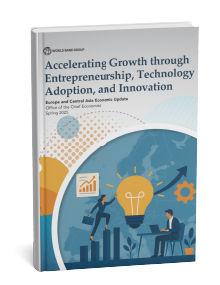Part I: Recent Developments, Policies, and Outlook
On average, economic growth across the developing economies of Europe and Central Asia is expected to slow to 2.5% in 2025-26 owing to weaker external demand and a slowdown in Russia.
Risks are heavily tilted to the downside. Heightened global policy uncertainty, trade fragmentation, increased trade barriers, geopolitical tensions, and financial market volatility dominate. Serious challenges could arise from weaker than-anticipated economic expansions in key trading partners, further adverse shifts in global trade policy, and continued softening of commodity prices. Tight labor markets and potential supply-side shocks could exacerbate inflation, but how these factors will develop remains to be seen.
Part II: Accelerating Growth through Entrepreneurship, Technology Adoption, and Innovation
In the current challenging global economic environment, it is crucial for the region to accelerate growth by improving the business environment and fostering buoyant private sector development. Yet business dynamism and economic activity have weakened noticeably since the late 2000s, with productivity growth largely driven by resource allocation across firms rather than innovation.
The report suggests breaking this cycle by facilitating innovation, enabling the most productive firms, strengthening competition policies, deepening financial markets, and increasing research and development (R&D) investment. By prioritizing these reforms, the developing economies of Europe and Central Asia can encourage an enterprise-driven growth model, which is essential for creating better-paying jobs and achieving and sustaining high-income status.





